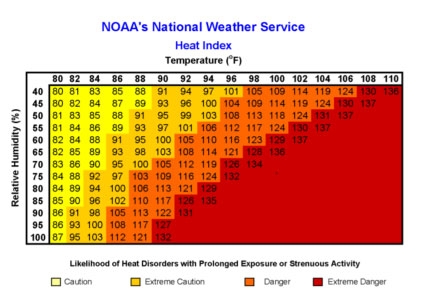New York Racetrack Heat Management Protocol

Some objective guidelines may be helpful for racetrack operators to manage the racing schedule for hot summer days. The core question is: "When does it become too hot to safely conduct racing at your racing facility?"
Horses are generally able to keep their core temperature within normal limits in most extreme weather conditions. However, individual horse factors will also come into play. Horses that are fit and well-conditioned are more capable of exercising in hot weather than those who are not well-conditioned or acclimated to hot weather. High ambient temperatures and humidity make it more difficult for horses to avoid overheating. When horses exercise, their muscles generate heat and that heat must be dissipated in order to prevent potentially serious complications. Sweating and the evaporation of sweat, along with dilation of blood vessels in the skin are the primary mechanisms for horses to dissipate this heat. When the temperature and humidity are high, it is more difficult for the horse to dissipate heat through these normal cooling mechanisms. Failure to cool down after strenuous exercise in hot humid weather can cause horses to experience heat stress or even heat exhaustion.
In order to minimize the risk for serious heat related health issues, racetracks should continually monitor the heat index and evaluate how the horses come back after each race in order to make real-time assessment of the ability of the horses to cope with high temperatures and humidity. The heat index is a calculation that takes into consideration the ambient temperature, humidity and wind speed. The heat index is available locally from the weather station and is updated every 15 minutes. If the NOAA heat index reaches 105 (see chart below), the racetrack veterinarian should contact the stewards and track management to advise them of the presence of dangerous weather conditions. A discussion among the track veterinarian, stewards, horsepersons and racetrack management will follow with a recommendation to cancel racing if the local conditions are dangerous for horses and riders/drivers. This decision should be made in the morning before the first race, whenever possible. Alternatively, some racetracks simply add the temperature and percent humidity values together to determine a cut-off point for cancelling the racing card. In the absence of mitigating circumstances, if the combination of temperature and percent humidity approaches 160 (e.g.: Temperature of 100 degrees F and 60% humidity), racing should be cancelled in the interest of safety for the horses and riders/drivers. Note that this approach does not take into consideration the wind factor.
If horses can race, precautions are put in place to minimize heat stress. Horses can be hosed and covered with light sheets soaked in ice water to keep them cool on their way to the paddock. Horses are observed continually as they approach the paddock, while they are in the paddock, during the warm-up period, while racing and as they leave the racing surface. Buckets of ice and cold-water hoses should be made available all around the racing oval, in the paddock and at the winner's circle for emergency use. As soon as the water on the body surface becomes warm, it should be scraped off to help enhance evaporation. Following the race, horse persons cool out their horses with hosing, ice water and walking to help restore normal body temperature. Horses can intermittently drink small amounts of cold water as they are walked and may also be placed in the shade or in front of fans to enhance evaporation of sweat and water from the skin surface. (See heat advisory on the NYSGC Website). The horse's body temperature should be monitored until it returns to a normal level of 101F. Horses with a persistently elevated body temperature should receive veterinary attention.
-Scott E. Palmer, V.M.D.
New York State Gaming Commission Equine Medical Director
